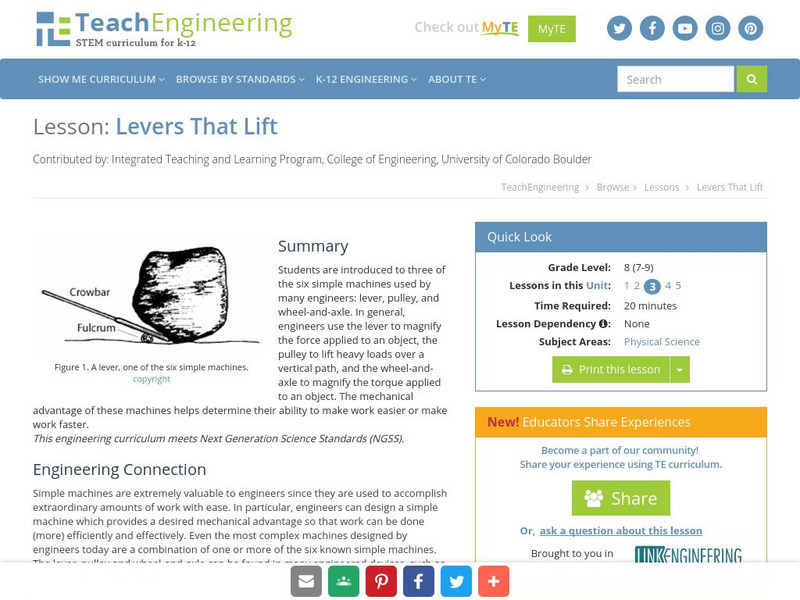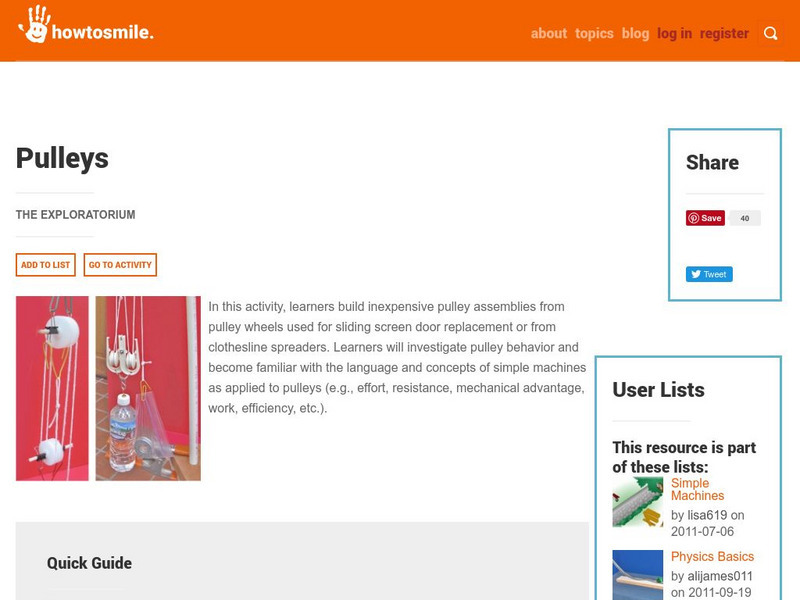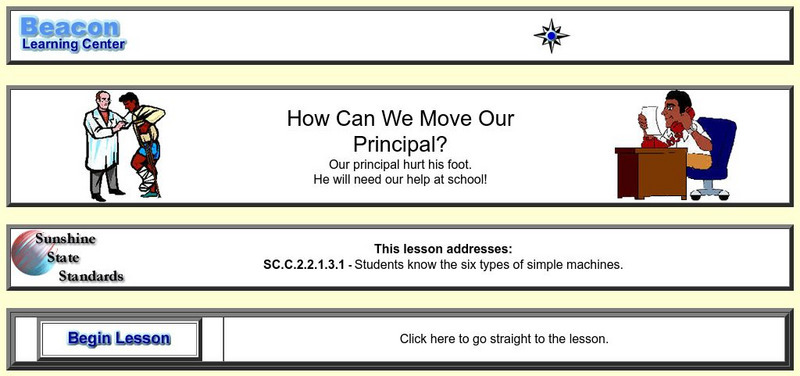Ducksters
Ducksters: Physics for Kids: Simple Machines
Kids learn about the science behind simple machines such as levers, wheels, pulleys, inclined planes, and screws. How they work together to make complex machinery.
The Franklin Institute
Spotlighting Simple Machines
Simple machines such as inclined planes in wedges and screws are explained.
NASA
Nasa: Simple Machines
A lesson plan site that contains activities designed to give grades 3 and 4 experiences in using simple machines.
TeachEngineering
Teach Engineering: Simple Machines and Modern Day Engineering Analogies
Students apply the mechanical advantages and problem-solving capabilities of six types of simple machines (wedge, wheel and axle, lever, inclined plane, screw, pulley) as they discuss modern structures in the spirit of the engineers and...
TeachEngineering
Teach Engineering: Levers That Lift
This lesson introduces students to three of the six simple machines used by many engineers: the lever, the pulley, and the wheel-and-axle. In general, engineers use the lever to magnify the force applied to an object, the pulley to lift...
Read Works
Read Works: Machines Can Move
[Free Registration/Login Required] An informational text about simple machines people use every day. A question sheet is available to help students build skills in reading comprehension.
Read Works
Read Works: Machines Can Move!
[Free Registration/Login Required] An informational text about simple machines used in daily life such as: a pulley, a screw, an inclined plane, a wheel and axle, a wedge, and a lever. A question sheet is available to help students build...
TeachEngineering
Teach Engineering: Powerful Pulleys
Students continue to explore the story of building a pyramid, learning about the simple machine called a pulley. They learn how a pulley can be used to change the direction of applied forces and move/lift extremely heavy objects, and the...
TeachEngineering
Teach Engineering: Machines and Tools, Part Ii
In this activity, students gain first-hand experience with the mechanical advantage of pulleys. Students are given the challenge of helping save a whale by moving it from an aquarium back to its natural habitat into the ocean. They set...
TeachEngineering
Teach Engineering: Pulley'ing Your Own Weight
Using common materials (spools, string, soap), students learn how a pulley can be used to easily change the direction of a force, making the moving of large objects easier. They see the difference between fixed and movable pulleys, and...
University of Houston
University of Houston: Simple Machines Learning Site
Simple descriptions and drawings of simple machines. Click on each image for a further explanation and examples.
ClassFlow
Class Flow: Simple Machines Quiz
[Free Registration/Login Required] This flipchart consists of a humorous quiz on identifying simple machines and forces of motion such as gravity and inertia.
CK-12 Foundation
Ck 12 Exploration Series: Simulations: Physics: Block and Tackle
[Free Registration/Login Required] A video module where students learn about the relationship between force, work, energy, and mechanical advantage using a simple machine.
Science Struck
Science Struck: Examples of Pulleys in Daily Life
Learn how pulleys work and their many uses in everyday life, industry, recreation, and other activities. Includes many pictures of pulleys and pulley systems.
CK-12 Foundation
Ck 12: Physical Science: Pulley
[Free Registration/Login may be required to access all resource tools.] What a pulley is and the three basic types, and the mechanical advantage of a pulley.
TeachEngineering
Teach Engineering: The Power of Mechanical Advantage
Students learn about the mechanical advantage offered by pulleys in an interactive and game-like manner. By virtue of the activity's mechatronic presentation, they learn to study a mechanical system not as a static image, but rather as a...
Science Buddies
Science Buddies: Give Yourself a Lift: Lightening the Load With Pulleys
Before the Industrial Age, people relied on muscle power for moving and lifting heavy objects. Here's a project that shows you how you can use your head to make heavy lifting easier on your muscles - and your back.
Other
How to smile.org: Building Pulleys
An activity where young scholars use pulley systems to pick up a paint can and move an eraser from the ground to the top of a desk. After completing this activity, students will understand how pulley systems can help us do work.
Science and Mathematics Initiative for Learning Enhancement (SMILE)
Smile: Simple Machines
Good combination of teacher demonstration and student interaction for this simple machine lesson. Great for talking about force and work. Plans are for grades 2-4, yet are adaptable.
NASA
Nasa: Simple Machine Resource Chart
This site provides a chart that lists the six simple machines, defines them, explains how it helps and gives examples.
Beacon Learning Center
Beacon Learning Center: How Can We Move Our Principal?
In this problem solving exercise, students must decide which simple machine would work best in different situations, in order to help the principal manoeuvre himself after he has hurt his leg and can't walk. The site has a good tutorial...
Other
Professor Beaker's Learning Lab
This site provides information on simple machines in machines and features links to a question and answer section as well as a learning lab.
Concord Consortium
Concord Consortium: Molecular Workbench Showcase: Physics, Mechanics
A collection of simulations representing concepts discussed in a mechanics unit of physics.
The Franklin Institute
Franklin Institute Online: The Pulley
This site provides an easy to understand experiment that will demonstrate the pulley to students in grades K-3. It requires only everyday materials. The students are encouraged to discover some of these concepts for themselves and apply...



















